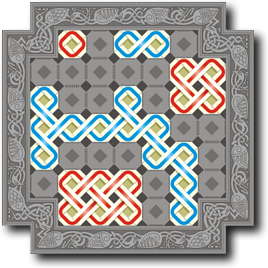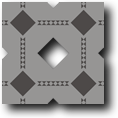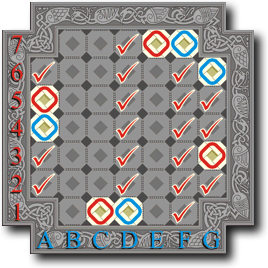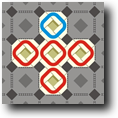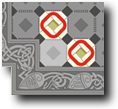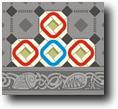Sign up for the Knotiverse / Tailten Games Newsletter
Your address is always private - we hate spam too.
If you don't get your confirmation email, please check your spam folder.
If you don't get your confirmation email, please check your spam folder.
TARA - POISONED CHALICE
Singles - Kingdoms
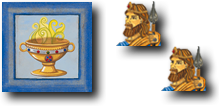
Shift gear with this one - it turns the tables - literally! It’s a battle of spirits between High King Lóegaire and St. Patrick. Players sit at right angles to each other, pitting their wits against the unknown powers of the enemy. Get your head around this, take control of the enemy and watch them squirm!
2 Players
2 Players
REVISED
AIM
PREPARATION
- Sit at right angles to your opponent with the empty board set squarely between you.
- Each of you takes the tiles of your chosen colour, ignoring the kings.
- Draw lots to determine who starts.
GENERAL RULES
- Passing is not allowed.
- Once you touch a hill you are committed.
FIRST PHASE - MANOEUVRES
- Each player takes turns to build (place) one ringfort on an empty hill.
- Manoeuvres comprises just eight turns (four turns each); each player building just one ringfort in each of the board's four edges.
- The first player must build a ringfort anywhere on any board edge.
- Subsequently, each player in turn must build their ringfort so that none are built opposite another, figs. 1 & 2.

fig. 1: Red sits along board edge marked with Red numbers 1-7. Blue sits along board edge marked with Blue letters A-G. Red built first on E7, so Blue must build on any edge hill, marked with a tick except E1 (opposite E7).
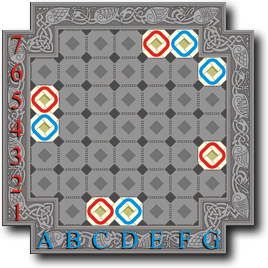
fig. 2: End of Manoeuvres - each player has built one ringfort on each board edge. None are built opposite another.
SECOND PHASE - BATTLE
- Because you are sitting at right angels to each other, you will each have a different perspective of the board.
- Before each turn, you must assess your own individual rows, figs. 3 & 4, (running horizontally to yourself) for qualified rows.
- Now, each player takes turns to build one ringfort on an empty hill, anywhere in a qualified row. Therefore, you must not build in an empty row (each player has one initially) and you must not build in a row if you have more ringforts than your opponent.
- As friendly ringforts are built adjacently, they are all linked automatically in the same turn.
- If you have no qualified rows you must capture an enemy ringfort if you can. If you cannot capture a ringfort, you must build a ringfort anywhere you like.

fig. 3: Red's rows.
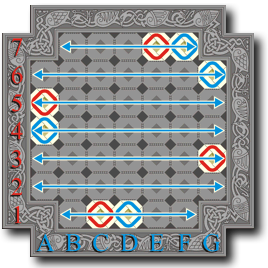
fig. 4: Blue's rows.
CAPTURING RINGFORTS
- If you besiege an isolated enemy ringfort, it may be captured later in the game. Capturing ringforts is not automatic (as opposed to Sacred Hill) and it may only happen when you have no qualified rows.
- If you have more than one to capture, you may choose which one to capture first.
- The ringfort is removed, then replaced by one of your own and linked, all in the same turn, fig. 5.
- Capturing takes a complete turn. You must not build another ringfort in that turn. You may capture only one ringfort per turn.
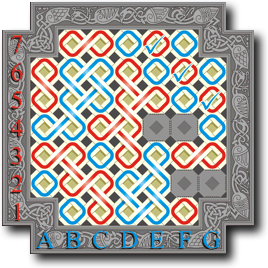
fig. 5: Blue has no qualified rows and must choose which ringfort to capture.
ILLEGAL MOVES
- If you make an illegal move and it's spotted before your opponent takes their next turn, your opponent may order you to remove that ringfort, and then replace it somewhere else of their own choosing in accordance with the rules pertaining at the time.
END OF THE GAME
- The first player to not have a legal turn calls "OUT". The other player then just has one more turn before the game ends. REVISED
- Note: the board will always be full and only one player should have any besieged ringforts remaining (if any).
SCORING
- The winner is the player with the fewest number of kingdoms. The winner scores 2 points, plus bonus points for the difference in the number of kingdoms. For example, if the outcome was 1 to 4 kingdoms, the winner would get 3 bonus points. The other player does not receive points, fig. 6.
- If both players have the same number of kingdoms, the winner is the player with most territory. The winner scores 2 points, plus bonus points for the difference in territory. For example, if the outcome was 24 to 21 ringforts, the winner would get 3 bonus points. The other player does not receive points.
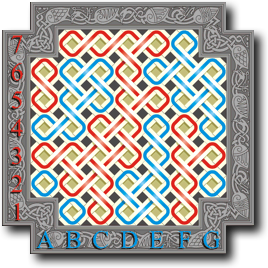
fig. 6: Finished game: Red has 3 kingdoms and Blue has 6, so Red wins. Red scores 2 points (for the win) plus 3 bonus points (for the difference between 3 and 6) which equals 5 points. Note: only Blue has any single ringforts remaining.
